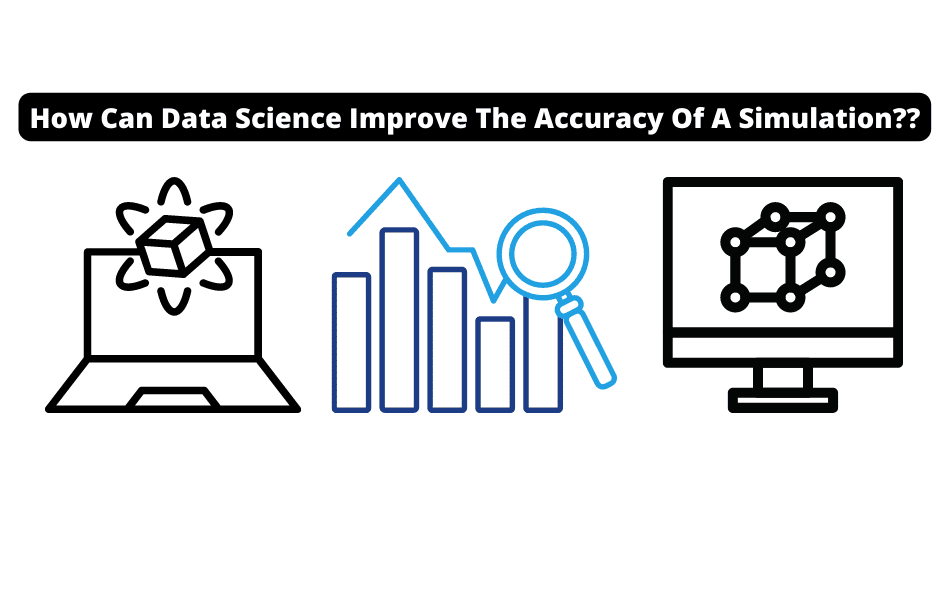Data Science is a field of study that uses mathematics, statistics, and computer science to analyze and make sense of large amounts of data – which is perfect since it can also be used to improve simulations.
Think of a simulation as a virtual representation of a real-life scenario.
Simulation is used in basically every field, such as engineering, science, and finance.
Using data science techniques, we can better understand the data used in our simulations, leading us to better outputs. We can make simulations even more accurate and reliable by taking advantage of data science.
Whether you’re a student, a scientist, or just someone interested in making your simulations a bit more accurate, you’ll learn something new and valuable from this post.
So let’s jump right in!

What Exactly Is A Simulation?
A simulation is a virtual representation of a real-life scenario.
It’s like a model of a real-world situation, but it exists in a computer or a virtual environment. Think about a video game highly representative of the real world since it was built with statistics of the world behind it.
The goal of a simulation is to make the simulation as close as possible to what might actually happen in real life.
For example, if you wanted to know what would happen if you added an extra person to a line at the airport, you could create a simulation to study that specific situation. This would help you understand how the line would change anything and everything relevant to the line and what secondary effects it might have.
They allow us to study and analyze real-world scenarios without physically carrying out the experiment or situation.
This saves time, money, and resources and allows us to study situations that might be too dangerous, difficult, or expensive to study in real life.

How Can Data Science Improve The Accuracy Of A Simulation?
Data science can be a valuable tool for improving the accuracy of simulations.
Using everyday data science techniques, we can get more accurate simulation inputs and better understand the outputs.
Here’s how:
Accurate Inputs
Data science techniques can be used to extract highly accurate and relevant distributions and rates from data.
This is perfect because you’ll need data if you plan to do any simulations.
This extracted information can then be directly plugged into our simulations, creating more accurate – and thus more representative – simulations.
For example, suppose we were trying to simulate traffic movement in a city. In that case, data science could help us gather data on traffic patterns, road conditions, and other factors that highly affect the simulation.

Think about it this way, if you were given a very messy dataset, how would you find the numbers needed to supply your simulation?
To get these, you’d pull directly from data science techniques, allowing you to quickly find the patterns and distributions in your data to build your simulation model.
Fake Data
Data science can also be used to create fake or synthetic data for simulations. This can be especially useful when actual data is unavailable, too difficult, or expensive to collect.
Using statistical methods, machine learning algorithms, predictive analytics, and correlation to compute and predict new values, data scientists can generate synthetic data that highly resembles high-quality data.
This synthetic data can then be used in simulations to test and evaluate different scenarios for which data scientists can’t find relevant data.
For example, suppose we were trying to simulate the spread of a disease in a population. In that case, data science could help us generate synthetic data on the population’s demographics, health status, and movement patterns – without needing the actual “real” population data.

This synthetic data could then be used in the simulation to study how the disease might spread under different conditions.
The benefit of using synthetic data is that it allows us to create simulations without relying on actual data.
This can also save time, money, and resources, allowing us to study situations that might be too dangerous, complex, highly unique, or expensive to study in real life.
Handle Large Data
Data science can be a valuable tool for improving the accuracy of simulations by allowing us to process high amounts of data.
With the help of data science techniques, we can analyze and make sense of large amounts of data, which can be used in simulations to create more accurate simulations of real-world scenarios.
For example, suppose we were trying to simulate adding a new bank in a city. In that case, data science could help us gather data on other banks, spending habits, and other factors that would have a noticeable effect on the simulation.

With this information, we could create a more accurate simulation of money flow in the city and even simulate other things like adding a couple of banks or a new restaurant.
Understanding Outputs
Data science can also help us better understand the outputs of simulations.
While data is hard to understand, data science techniques show us what to look for in data, giving us an almost end goal to the data received from our simulations.
By analyzing the simulation results, we can identify patterns and trends and make more informed decisions about improving the simulation.
Another Avenue
Data science can help create more accurate simulations by literally allowing us to generate more simulations.
While most receive their simulation values and have to be happy with them, Data science techniques, such as machine learning algorithms and statistical methods, can help us quantify new avenues and angles from our data, leading us to create more simulations.
Does Accuracy Matter In A Simulation?
Accuracy matters in simulations because it helps us make better decisions and predictions.
By creating simulations that are as close as possible to what might happen in real life, we can better understand the situation and make more informed decisions about improving it.
In most fields, such as engineering, science, and finance, accuracy is critical since the difference of inches or percentages has a massive effect on the world around us.

Why Do We Need Simulations, If We Have Data Science?
Data science and simulations are tools that fall under the umbrella of statistics, and they have unique benefits and purposes.
Data science can be used to analyze and make sense of large amounts of data, and it provides us with answers/predictions for one point in time.
For example, if we were trying to understand how many people in a city use the public restroom, data science could quickly predict the whole year (if you had the data).
However, simulations allow us to see how things change over time.
They visually represent a real-life scenario and help us understand how things might change or evolve.
If we were trying to understand how traffic might build up in a city in the future, we could use a simulation to study the situation. This would help us understand how the traffic might change over time and what might happen when certain conditions change.
In short, we need simulations because they allow us to see how things change, while data science provides answers for one point in time. Both data science and simulations are valuable tools in the field of statistics, and they can be used together to understand real-world scenarios better.
Other Articles In Our Accuracy Series:
Accuracy is used EVERYWHERE, which is fine because we wrote these articles below to help you understand it
- Can Machine Learning Models Give An Accuracy Of 100
- What Is a Good Accuracy Score In Machine Learning?
- High Accuracy Low Precision In Machine Learning
- Data Science Accuracy vs. Precision
- Machine Learning Validation Accuracy
- Machine Learning: High Training Accuracy And Low Test Accuracy

